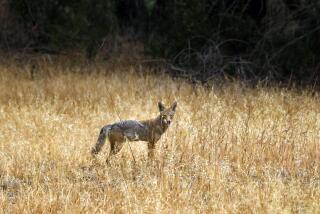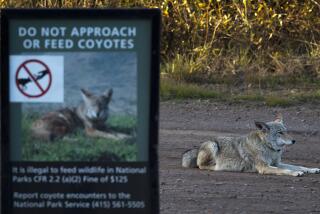Western Icons Making Dens in the Eastern U.S.
WASHINGTON — For several months, people had been seeing them among the trees, most often in the long light of dusk: lithe, clandestine creatures slinking over the hillsides that mark the city limits.
“I was driving up Oregon Avenue with my son, and somewhere about 7 in the evening, we both saw this dog-like mammal,” said Frank Buchholz, who lives in the Chevy Chase section of northwest Washington.
“We both said, ‘Coyote.’ ”
Buchholz questioned his assumption for days, until National Park Service ranger Ken Ferebee spotted a furry interloper Sept. 19 while conducting a nocturnal deer count in Rock Creek Park, a natural green valley that winds through Buchholz’s neighborhood.
“It was just out in some high grass under some oak trees, probably eating acorns,” Ferebee said. More sightings followed in October and November.
“We’re not sure how many we have at this point,” Ferebee said. “At least two, maybe four or five.”
Coyotes, the subject of folklore and the scourge of ranchers, have finally made their way into the nation’s capital.
The coyote population has been expanding eastward since the middle of the last century. Native to California and most points in the West, the creatures made a two-pronged advance over the years -- into New England through Canada and the Great Lakes region, and up through the South from Texas.
“The story is an official finally saw one, but people have been reporting them for years,” said Christine Montuori, director of Second Chance Wildlife Center in Gaithersburg, Md.
“I think it’s just a natural migration because their traditional areas are being taken over,” she said. “They’re very adaptive -- people have been trying to wipe them out for a long time.”
Coyotes belong to the family Canidae, which includes the wolf, the fox and the common dog. About 2 feet high at the shoulders, the long-legged animals sport a mottled gray coat, a cream-colored underbelly, a long snout, upright ears and a black-tipped tail; in dim light, a coyote can resemble a thin German shepherd.
They typically weigh between 30 and 35 pounds, although recent evidence points to the species growing larger as it has moved east. In Connecticut, researchers have caught males weighing close to 50 pounds.
The difference in size from their Western cousins has caused some scientists to question whether coyotes are forming a new subspecies in the East. Cold weather might have driven natural selection to favor bigger, better-insulated animals. Genetic evidence suggests that, as they migrated, they have bred with dogs and wolves, which could explain the extra pounds.
Coyotes are the garbage disposals of the natural world. Most active at dawn and in the late evening, they are both scavengers and hunters.
Living close to wolves, who have also returned to the continental U.S. in near-record numbers, coyotes can often be spotted cleaning up the remains of a pack’s kill. On the outskirts of cities, they’ve been known to take down a deer, but prefer smaller mammals such as squirrels, mice and hares. As such, domestic pets -- and their owners -- need to keep a wary eye.
“They often seem to have a real fondness for cats,” Montuori said.
The coyote’s place in U.S. history has been tumultuous. Once revered by Native Americans as a symbol of wisdom, they became the target of Western cattle ranchers, who tried to shotgun them into extinction. But since the mid-19th century, coyotes have expanded their territories threefold from their native regions on the Great Plains.
The surprising reason: Scientists have learned that the systemic killing of coyotes makes them multiply. The alpha males that control a pack and mate with the females are often the main targets of hunters. When those males are killed, the females mate more frequently with other males, breed at a younger age and produce larger litters. The greater number of coyotes then take over territories of other predators, such as wolves and cougars, that don’t bounce back as fast from attempted exterminations.
As their population has expanded, coyotes have encroached into urban centers. For instance, researchers have discovered them in every wooded hamlet in the metropolitan Chicago area, where the coyotes use aqueducts and railway tracks as their routes throughout the city.
“It’s an interesting psychological study, watching people’s reactions to them,” Laura Simon, urban wildlife director for the Fund for Animals, said from her office in New Haven, Conn. “We get calls here that coyotes are here to drag their children off.... People are scared to death of them. We have to correct a lot of misconceptions over our hotline.”
She noted that coyotes tended to avoid people at almost all costs, even going so far as to pass over garbage and other possible sources for a quick meal rather than risk contact.
“Coyotes, even in suburban areas, tend to make an honest living,” Simon said. “They ate what they were supposed to eat.”
In other places, however, the highly intelligent animals have learned they can sometimes take what they want.
In California, officials have been dealing with coyote nuisance calls for decades. Animal control experts in Los Angeles County trap and kill about 80 a year. In Santa Clara, a pack of coyotes has been causing mischief in a gated community for the last 18 months -- stalking people as they walk their dogs, sneaking into garages, attacking pets that wander outdoors, and knocking down garbage cans.
A vaguely worded warning sign tacked to a tree last summer in Rock Creek Park has been the only indication of a possible coyote attack against a pet in the District of Columbia. Neither the National Park Service, which has jurisdiction over the park, nor animal control officials in Montgomery County, Md., just over the city limits, have received reports of attacks.
Coyotes’ assimilation into cities has spurred another evolution -- in the methods used to deal with them.
“We call it a coyote problem, but it often comes down to a people problem,” said Camilla Fox, director of wildlife programs at the Sacramento-based Animal Protection Institute. With a firm stand against killing coyotes or even relocating them -- which is illegal in many states, including California -- Fox said the only viable solution was to teach people to coexist with them by keeping pet food indoors, cleaning up yards and putting a tight lid on trashcans.
“They will eat anything, from dog food and cat food to Fifi and Fido,” said Fox, who encourages people to carry blow horns and whistles “to help reinstill in coyotes their natural fear of humans.”
The District of Columbia does not share California’s pressing need to address human-predator interactions -- at least not yet. The National Park Service is making plans to monitor the animals in Washington and surrounding areas. In the spring, rangers will use motion-sensitive cameras with the hopes of locating breeding dens in Rock Creek Park.
But even without a den sighting, there’s strong evidence that coyotes are a permanent fixture.
“I doubt they’re going to disappear,” said Montuori, of the Second Chance Wildlife Center. “Whether they become a problem here is really anybody’s guess.”
More to Read
Sign up for Essential California
The most important California stories and recommendations in your inbox every morning.
You may occasionally receive promotional content from the Los Angeles Times.










